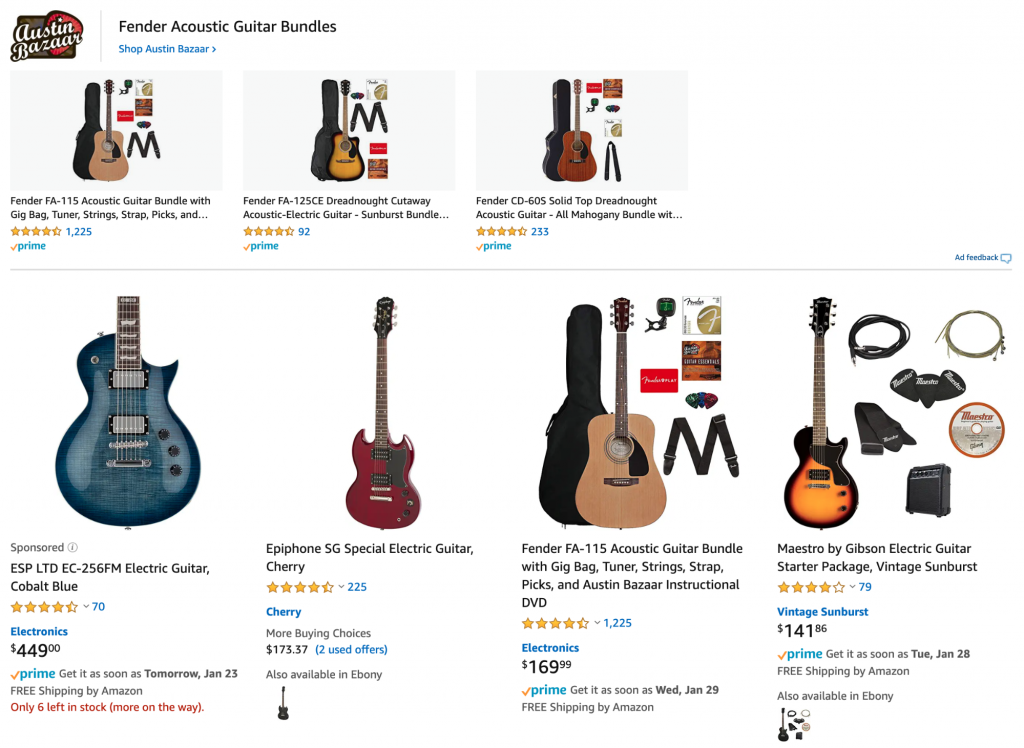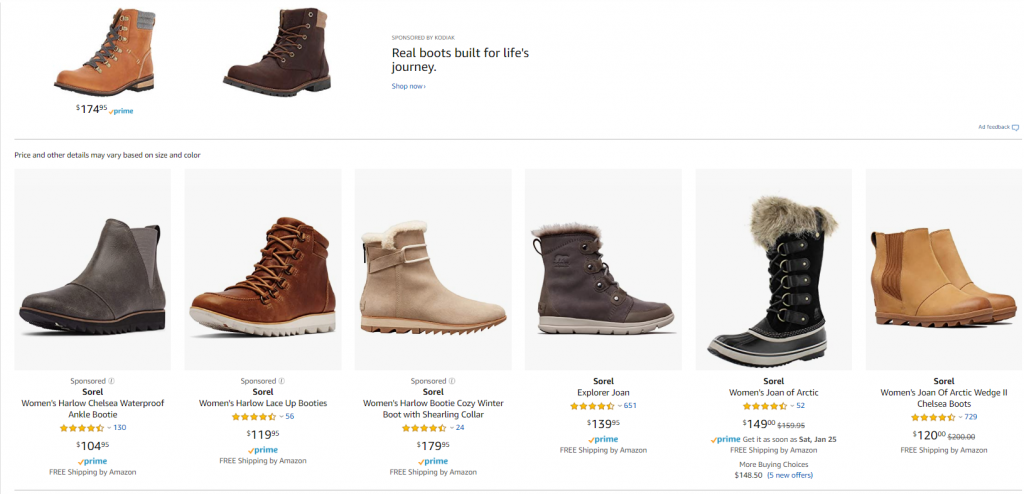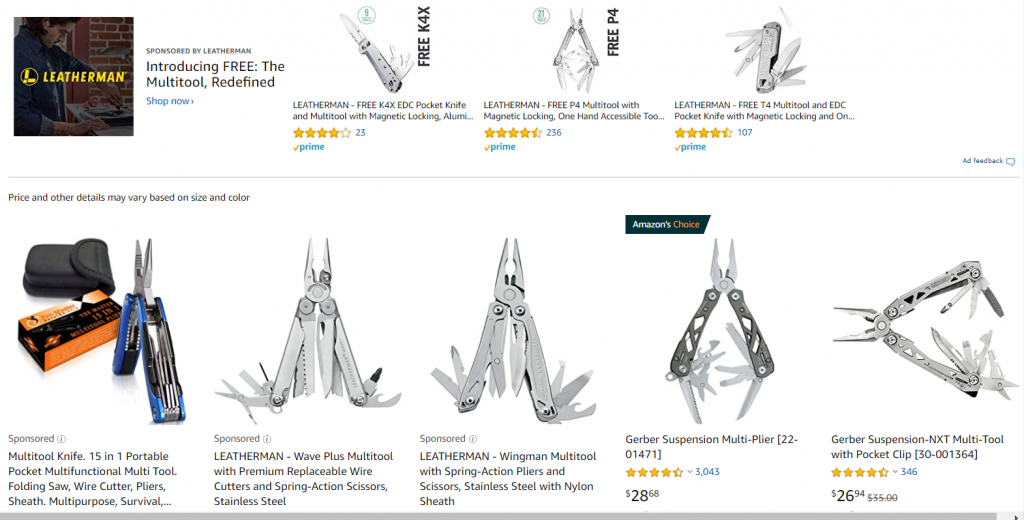Amazon Advertising is More Than a Conversion Tool
Many digital marketing teams consider Amazon advertising to be a tool for harvesting existing demand. They know that Amazon shoppers are ready to buy, and paying to advertise on the right keywords is the key to winning the sale. While that can be true, it’s only one small piece of a complete strategy with Amazon advertising.In addition to driving conversions, there are several ways brands should think of Amazon advertising.
Defending Brand Terms
The first several positions on every Amazon search results page are paid placements, even for “branded” terms, such as exact product names and the names of the brands themselves. Unless a brand is buying the top positions for their own branded terms, it’s easy for a competitor to steal those spots.Take the search term “Gibson guitar” as an example. In the banner, there’s a prominent ad featuring Fender — Gibson’s fiercest competitor. In the next position, there’s an ad for an ESP guitar, which is clearly modeled after Gibson’s famous Les Paul. In all of the top row, there’s not a single mainline Gibson guitar. Although Epiphone and Maestro are Gibson-owned brands, they appeal to a quite different consumer — meaning the search results are not ideal for the brand or the shopper. Now let’s take a look at Leatherman. Similar to Gibson’s dominance in the guitar category, Leatherman is a leading brand in the multitool category; both brands are well known and respected within their consumer bases. The top position of their branded search results, as well as the entire first row, are all Leatherman products. This is ideal for both the brand and loyal shoppers that intentionally search for Leatherman by brand name — which is common among category-leading manufacturers. If a brand doesn’t have a strategy around defending branded keywords, it’s all too easy for a competitor to swoop in and win top positions. That’s why having a strategy for defense is an essential part of Amazon advertising.
Online Merchandising
Merchandising is just as important in the online marketplace as it is in traditional brick and mortar. On Amazon, the search results page is the equivalent of what a shopper sees on a store shelf, and just like a physical store shelf, product positioning matters.Amazon advertising can be used to strategically change up which products are being shown in certain spots according to seasonality, product promotions, and consumer demand. Take Sorel — Netrush partner and premium footwear brand — as an example. This screenshot was taken during the winter season. In this case, weather-focused footwear— waterproof and winter boots — are placed in top positions as part of a seasonal campaign.Promotional spots give brands the opportunity to drive attention to certain products. Deciding what product to put first depends on campaign goals. Maybe a brand is trying to introduce a new product line or boost an underperforming product. No matter what the goal is, this level of merchandising is only possible through Amazon advertising.
Reaching higher-funnel shoppers
As mentioned earlier, Amazon advertising is a very effective means of harvesting shoppers that are already in the decision phase of the buyer’s journey, but it can also be used to target those still in the consideration phase. This involves targeting higher-level keywords and associating with similar brands.In Leatherman’s case, an example of a consideration phase keyword would be “multitool.” In this instance, Leatherman won a majority of top positions of the search engine results page (SERP), including the top banner and two out of three paid spots. One competing brand is also present, but that’s to be expected in a more competitive category. Holding positions for higher-level keywords puts brands in front of shoppers that are considering their options.A strong Amazon advertising strategy takes a broad range of goals into account and then balances cost and margin to come up with the best possible plan for the brand itself. Flat, or even negative ROI from certain campaigns could be acceptable as long as the results themselves were expected, and part of an overall plan.
There’s no ‘finish line,’ when it comes to Amazon advertising. Since we cannot expect to out-spend all brands on all keywords at all times, it’s critical that we choose our targets wisely. Maximizing profit is our first priority, followed by brand health and strategic growth initiatives. A blend of all of the above is the secret to sustainable growth on Amazon. Pinky Gonzales, Netrush VP Marketing
Key Takeaways
Winning on Amazon advertising means more than harvesting low-funnel conversions. Amazon advertising is a powerful tool that can be used to reach shoppers in every stage of the buyer’s journey. A strong advertising strategy:
Defends branded terms. The first several spots in an Amazon search are all paid placements. If a brand isn’t careful, it’s all too easy for a competitor to bid on branded keywords and win those top spots.
Merchandises the digital shelf. Amazon advertising provides some control over what shoppers see first. Brands can use this to their advantage and promote products based on specific campaign goals.
Reaches higher-funnel shoppers. It’s not just about reaching low-funnel shoppers. Brands can appeal to shoppers in the consideration phase by being strategic with high-level keywords.
It isn’t always about positive ROI. At the end of the day, Amazon advertising should accomplish a brand’s goals. Knowing what those goals are, knowing what levers to pull, and knowing how to measure success is essential to winning on Amazon.
To learn more about digital marketing on Amazon, visit our Digital Marketing.




